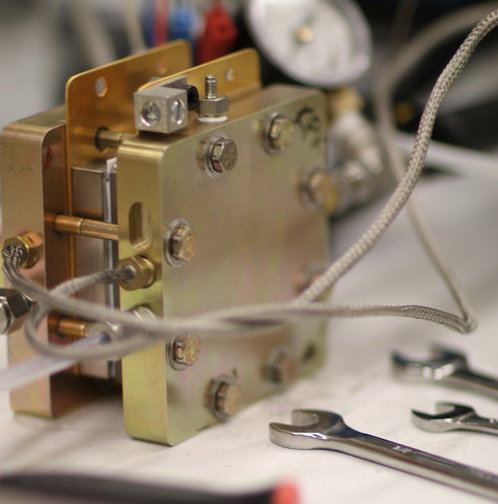Kendra Kuhl dreams of large reactors. That may sound odd, but the 36-year-old technologist is working toward a future where we can extract the globe-warming carbon dioxide in our atmosphere and turn it into useful productsKuhl is the co-founder and chief technology officer of Opus 12, a startup launched in 2014 to pursue electrochemical carbon dioxide reduction (the company launched under the name Obtainium, but changed it in 2015). The amount of carbon dioxide in our atmosphere has been rising steadily every year, so a technology that can reduce or at least stabilize those levels (so we don't revert back to Triassic-period conditions and die) would be really helpful.
Advertisement
Kuhl's team developed a prototype, a cube the size of a bedside alarm clock, that can achieve just that. In 2016, MIT Technology Review listed Kuhl as one of the top 35 innovators under 35, naming her among the people who are "building the stuff of the future."
"I wanted to do something beneficial to help the environment," Kuhl told me recently, adding that the she's been studying the science behind the reactor since she was a graduate student at Stanford University (where she got her PhD in chemistry in 2013). Opus 12 has won the Department of Energy's Transformational Award and several grants from organizations like NASA. The technology, she explained, "would enable us to turn what is now a waste product into something useable."Read More: Monster Icebergs Crowding Canada's Coast Are Likely Harbingers of Climate ChangeKuhl's reactor can turn carbon dioxide into products such as ethanol and methane. Those products themselves could potentially contribute to greenhouse gases. But the whole idea, Kuhl said, is to recycle CO2 "that otherwise would have gone into the atmosphere."The process begins with water, electricity and carbon dioxide. Basically, she explained, the reactor has two sides to it. "On one side, we're putting in water. When we apply voltage across the two sides, the water gets oxidized to make oxygen, and that releases protons and electrons," Kuhl said."I wanted to do something beneficial to help the environment."
Advertisement

Those particles travel through a membrane to the other side of the reactor, where the scientists put in carbon dioxide, which mixes with the particles on the surface of a catalyst, she added. "Depending on the identity of the catalyst and the reactor conditions, that determines what products we make," Kuhl said.According to Kuhl, the technology can scale to make kilograms of products, or tonnes of it. Right now, she spends most of her time transitioning the proof-of-concept testing that resulted in the Opus 12 prototype into a commercial small-scale reactor."Converting all US stationary CO2 emissions into liquid fuels would produce enough carbon-neutral fuel to replace the nation's gasoline demand twice over," the Opus 12 website reads.
This is a grand dream for the future, where reactors big enough could have global impacts. "Our ultimate vision is that we can create a way to recycle carbon dioxide back into materials and fuels that we use every day," she said. "But it's not like tomorrow we're going to have this reactor."So, I asked her, how many large reactors would it take to reduce or at least stabilize the increasing levels of carbon dioxide in our atmosphere?"There's a lot of CO2," Kuhl said, "Think about all the cars and power plants in the world."Given that you need water and electricity to make the reactor function, the greatest challenge Opus 12 faces is energy—big reactors with big effects would need massive sources of electricity. Aside from being bitterly ironic, burning fossil fuels to run the reactors (and clean up the abundance of CO2 in the atmosphere) would ultimately be counterproductive, so alternative energy sources would be needed."I think we need to start somewhere," Kuhl said. "This is certainly not a technology that alone is going to solve the problem."Subscribe to Science Solved It , Motherboard's new show about the greatest mysteries that were solved by science."Our ultimate vision is that we can create a way to recycle carbon dioxide back into materials and fuels that we use every day."
